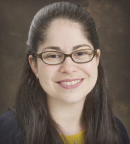
Deborah B. Doroshow, MD, PhD
Invited study discussant, Deborah B. Doroshow, MD, PhD, Assistant Professor of Medicine at the Tisch Cancer Institute, Icahn School of Medicine at Mount Sinai, in New York, noted that the current first-line treatment paradigm for patients with advanced NSCLC and no driver mutation is based on PD-L1 expression in tumor and/or immune cells. This has been driven by clinical trials that have used PD-L1 expression to organize patients and has led to FDA approvals for these subgroups, she said.
As Dr. Doroshow explained, however, many of the newer treatments in the first line are usable irrespective of PD-L1 expression, which is true of nivolumab/ipilimumab regimens as well.
“In CheckMate 9LA, benefit was seen in patients with all PD-L1 TPS [Tumor Proportion Score] scores using the Dako 28-8 assay, and only two cycles of chemotherapy were required compared with four in the other chemotherapy/immunotherapy options,” said Dr. Doroshow. She noted this regimen represents a second FDA-approved option for patients with squamous tumors, but it is effective in either histology.
“In CheckMate 227, benefit was also seen in all PD-L1 TPS groups, although FDA approval is currently in only patients classified as positive for PD-L1 expression,” Dr. Doroshow continued. “This represents a chemotherapy-free option, but the curves cross at 6 months, suggesting this regimen may not prevent early disease progression events.”
Key Questions Remain
According to Dr. Doroshow, two key questions remain: Which regimens offer the most durable responses? Which patients will benefit from the addition of CTLA-4 inhibition?
With respect to the durability of response, Dr. Doroshow noted that the survival curves of the various immunotherapy regimens in NSCLC, including pembrolizumab alone in the KEYNOTE-042 study, have significant overlap. In addition, the median and minimum follow-up times are quite disparate. “We really need more time to appreciate the full tail of each curve,” she observed.
With respect to patient stratification, Dr. Doroshow emphasized that better biomarkers are needed to predict response to ipilimumab, which can be associated with additional toxicity. She made a plea to “walk the walk” with respect to biomarker development.
“PD-L1 immunohistochemistry was developed as the primary heuristic for decision-making for patients with treatment-naive advanced NSCLC without a driver mutation. However, I would argue that it is becoming outdated,” she commented.
According to Dr. Doroshow, PD-L1 immunohistochemistry is associated with several problems. To begin, PD-L1 TPS may not predict improved overall survival in patients with squamous tumors, and there are multiple assays with some discordance, particularly the SP142 assay. There is also a lack of interpathologist concordance in interpreting PD-L1 expression in immune cells or PD-L1 TPS less than 50%, and there is significant temporal and intratumoral heterogeneity.
“Some of the many future directions [for biomarker development] include evaluation of tumor-infiltrating lymphocytes, multiplex immunostaining to assess spatial interactions among tumor and immune cells, and soluble PD-L1 measured over time,” Dr. Doroshow concluded. “It is critical that we build these novel biomarkers into large clinical trials, so they can be prospectively validated.”
DISCLOSURE: Dr. Doroshow has served as a consultant or advisor for Ipsen, Atheneum Partners, Boston Healthcare Associates, Dedham Group, and Guidepoint Global; has received research funding from Janssen Oncology, Dendreon, Novartis, Bristol Myers Squibb, Merck, AstraZeneca, and Genentech/Roche; and has been reimbursed for travel, accommodations, or other expenses from Ipsen.

